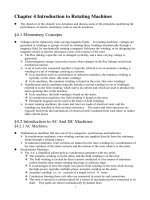Kendall7E ch04
Bạn đang xem bản rút gọn của tài liệu. Xem và tải ngay bản đầy đủ của tài liệu tại đây (885.3 KB, 51 trang )
Information Gathering:
Interactive Methods
Systems Analysis and Design, 7e
Kendall & Kendall
© 2008 Pearson Prentice Hall
4
Objectives
• Recognize the value of interactive methods for
•
•
•
•
•
information gathering
Construct interview questions to elicit human
information requirements
Structure interviews in a way that is meaningful to
users
Understand the concept of JAD and when to use it
Write effective questions to survey users about their
work
Design and administer effective questionnaires
Kendall & Kendall
4-2
Interactive Methods to Elicit
Human Information Requirements
• Interviewing
• Joint application design (JAD)
• questionnaires
Kendall & Kendall
4-3
Major Topics
•
•
•
Interviewing
• Interview preparation
• Question types
• Arranging Questions
• The interview report
Joint Application Design (JAD)
• Involvement
• location
Questionnaires
• Writing questions
• Using Scales
• Design
• Administering
Kendall & Kendall
4-4
Interviewing
• Interviewing is an important method for
collecting data on human and system
information requirements
• Interviews reveal information about:
• Interviewee opinions
• Interviewee feelings
• Goals
• Key HCI concerns
Kendall & Kendall
4-5
Interview Preparation
• Reading background material
• Establishing interview objectives
• Deciding whom to interview
• Preparing the interviewee
• Deciding on question types and
structure
Kendall & Kendall
4-6
Question Types
• Open-ended
• Closed
Kendall & Kendall
4-7
Open-Ended Questions
• Open-ended interview questions allow
interviewees to respond how they wish,
and to what length they wish
• Open-ended interview questions are
appropriate when the analyst is
interested in breadth and depth of reply
Kendall & Kendall
4-8
Advantages of Open-Ended
Questions
• Puts the interviewee at ease
• Allows the interviewer to pick up on
the interviewee's vocabulary
• Provides richness of detail
• Reveals avenues of further
questioning that may have gone
untapped
Kendall & Kendall
4-9
Advantages of Open-Ended
Questions (Continued)
• Provides more interest for the
interviewee
• Allows more spontaneity
• Makes phrasing easier for the
interviewer
• Useful if the interviewer is
unprepared
Kendall & Kendall
4-10
Disadvantages of Open-Ended
Questions
• May result in too much irrelevant detail
• Possibly losing control of the interview
• May take too much time for the amount
of useful information gained
• Potentially seeming that the interviewer
is unprepared
• Possibly giving the impression that the
interviewer is on a "fishing expedition”
Kendall & Kendall
4-11
Closed Interview Questions
• Closed interview questions limit the
number of possible responses
• Closed interview questions are
appropriate for generating precise,
reliable data that is easy to analyze
• The methodology is efficient, and it
requires little skill for interviewers to
administer
Kendall & Kendall
4-12
Benefits of Closed Interview
Questions
• Saving interview time
• Easily comparing interviews
• Getting to the point
• Keeping control of the interview
• Covering a large area quickly
• Getting to relevant data
Kendall & Kendall
4-13
Disadvantages of Closed
Interview Questions
• Boring for the interviewee
• Failure to obtain rich detailing
• Missing main ideas
• Failing to build rapport
between interviewer and
interviewee
Kendall & Kendall
4-14
Figure 4.5 Attributes of 0penended and closed questions
Kendall & Kendall
4-15
Bipolar Questions
• Bipolar questions are those that may be
answered with a ‘yes’ or ‘no’ or ‘agree’
or ‘disagree’
• Bipolar questions should be used
sparingly
• A special kind of closed question
Kendall & Kendall
4-16
Probes
• Probing questions elicit more detail
about previous questions
• The purpose of probing questions is:
• To get more meaning
• To clarify
• To draw out and expand on the
interviewee's point
• May be either open-ended or closed
Kendall & Kendall
4-17
Arranging Questions
•
Pyramid
• starting with closed questions and working toward
open-ended questions
•
Funnel
• starting with open-ended questions and working
toward closed questions
•
Diamond
• starting with closed, moving toward open-ended,
and ending with closed questions
Kendall & Kendall
4-18
Pyramid Structure
• Begins with very detailed, often closed
questions
• Expands by allowing open-ended
questions and more generalized
responses
• Is useful if interviewees need to be
warmed up to the topic or seem reluctant
to address the topic
Kendall & Kendall
4-19
Figure 4.7 Pyramid structure for interviewing
goes from specific to general questions
Kendall & Kendall
4-20









